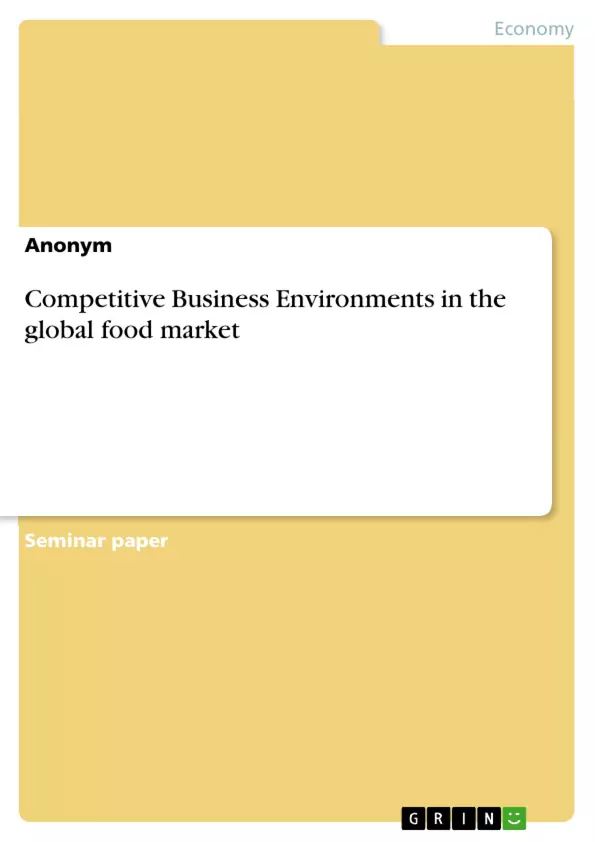This work focusses on the analysis of competitive factors in global market environments. In the first part, the global food market serves as an example for explaining how supply and demand factors influence prices. Furthermore, effects of rising prices are discussed as well as governmental possibilities to limit the impact. The second part consists of a detailed explanation of oligopolies, including characteristics and possibilities to control this type of market structure. Additionally, pricing strategies are discussed in conjunction with the elasticity of demand. The work concludes with an explanation of why companies decide to become multinational using the example of the Tommy Hilfiger Corporation.
Inhaltsverzeichnis (Table of Contents)
- Question 1: What have been the main demand and supply factors that have determined the general increase in global food prices over the last four years?
- 1.1 Introduction to the food market
- 1.2 Theory of supply and demand
- 1.3 Factors affecting demand for food
- 1.3.1 Population growth
- 1.3.2 Natural fuel
- 1.3.3 Standard of living
- 1.4 Factors affecting supply
- 1.4.1 Production costs
- 1.4.2 Weather conditions
- 1.4.3 Environmental sustainability
- 1.5 Conclusion
- Question 2: With reference to one specific agricultural commodity of your choice, examine in more detail the specific forces which have determined its price in recent years?
- 2.1 Maize price overview
- 2.2 Facts and figures about the maize market
- 2.3 Natural fuel
- 2.4 Other factors affecting demand and supply of maize
- 2.5 Conclusion
- Question 3: What are the effects of rising food prices on individual consumers and nations? Briefly suggest what governments can do to limit the impact of soaring food prices on their economies?
- 3.1 Changing diets and starvation
- 3.2 Social unrest
- 3.3 Water scarcity
- 3.4 Government responses
- 3.5 Conclusion
- Question 4: What are the main features of an oligopolistic market? With the aid of examples, show how collusion between firms in such markets may be detrimental to consumers and explain briefly what governments can do to control the worst abuses of such a situation.
- 4.1 Oligopoly a market structure
- 4.1.1 Non-collusive oligopoly
- 4.1.2 Collusive oligopoly
- 4.2 Disadvantages for consumers
- 4.3 Government control
- 4.4 Conclusion
- Question 5: Explain the various types of pricing strategies which companies can adopt in the face of competition in the marketplace. How would a knowledge of elasticity of demand help companies decide how to price their products?
- 5.1 Factors influencing the choice of a pricing strategy
- 5.2 Elasticity of demand
- 5.3 Pricing strategies
- 5.3.1 Price-skimming and penetration pricing
- 5.3.2 Product line pricing
- 5.3.3 Price discrimination
- 5.3.4 Further pricing strategies
- 5.4 Conclusion
- Question 6: Why do many large firms decide to operate beyond their home country, i.e. become multinational? With the aid of a case study of a particular company of your choice show how and why that company expanded abroad.
- 6.1 Introduction of multinational corporations
- 6.2 Motives for becoming a multinational
- 6.3 Case study - Tommy Hilfiger Corporation
- 6.4 Conclusion
Zielsetzung und Themenschwerpunkte (Objectives and Key Themes)
This text examines the key economic factors contributing to global food price increases in recent years, focusing on the interaction of supply and demand forces. It delves into specific factors influencing demand, such as population growth and changing consumption patterns, as well as those impacting supply, including production costs and weather conditions. The text also explores the ramifications of rising food prices on both individual consumers and nations, including potential social unrest and government responses.
- Global food price fluctuations
- The interplay of supply and demand in the food market
- The impact of population growth and consumption trends on food demand
- The role of production costs, weather patterns, and environmental sustainability in food supply
- Economic and social consequences of rising food prices
Zusammenfassung der Kapitel (Chapter Summaries)
Chapter 1 introduces the food market and its dynamics, explaining the core principles of supply and demand. It explores various factors influencing both demand and supply, including population growth, the shift towards biofuel production, and rising standards of living.
Chapter 2 delves deeper into the price dynamics of a specific agricultural commodity, focusing on maize. It examines the factors impacting its demand and supply, highlighting the role of natural fuel and other economic forces.
Chapter 3 analyzes the effects of increasing food prices on individuals and nations, discussing issues like changing diets, social unrest, and water scarcity. It also explores potential government interventions to mitigate the impact of rising food prices.
Chapter 4 explores the characteristics of oligopolistic markets, where a few firms control a significant portion of the market share. It examines the potential for collusion between these firms and its negative consequences for consumers, while outlining potential government regulations to address such situations.
Chapter 5 examines diverse pricing strategies that companies employ in competitive markets. It explores the concept of elasticity of demand and how it aids companies in determining optimal pricing strategies.
Chapter 6 investigates the motives behind large corporations expanding their operations beyond their home countries, becoming multinational. It uses the case study of Tommy Hilfiger Corporation to illustrate the mechanisms and drivers behind international expansion.
Schlüsselwörter (Keywords)
This text focuses on global food prices, supply and demand dynamics, population growth, biofuel production, food security, market structures, oligopoly, collusion, pricing strategies, elasticity of demand, multinational corporations, and international expansion.
- Quote paper
- Anonym (Author), 2008, Competitive Business Environments in the global food market, Munich, GRIN Verlag, https://www.grin.com/document/283709



